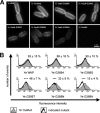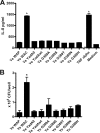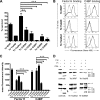Trimer stability of YadA is critical for virulence of Yersinia enterocolitica
- PMID: 20308293
- PMCID: PMC2876551
- DOI: 10.1128/IAI.01350-09
Trimer stability of YadA is critical for virulence of Yersinia enterocolitica
Abstract
Yersinia adhesin A (YadA) is a trimeric autotransporter adhesin with multiple functions in host-pathogen interactions. The aim of this study was to dissect the virulence functions promoted by YadA in vitro and in vivo. To accomplish this, we generated Yersinia enterocolitica O:8 mutants expressing point mutations in YadA G389, a highly conserved residue in the membrane anchor of YadA, and analyzed their impact on YadA expression and virulence functions. We found that point mutations of YadA G389 led to impaired transport, stability, and surface display of YadA. YadA G389A and G389S mutants showed comparable YadA surface expression, autoagglutination, and adhesion to those of wild-type YadA but displayed reduced trimer stability and complement resistance in vitro and were 10- to 1,000-fold attenuated in experimental Y. enterocolitica infection in mice. The G389T, G389N, and G389H mutants lost trimer stability, exhibited strongly reduced surface display, autoagglutination, adhesion properties, and complement resistance, and were avirulent (>10,000-fold attenuation) in mice. Our data demonstrate that G389 is a critical residue of YadA, required for optimal trimer stability, transport, surface display, and serum resistance. We also show that stable trimeric YadA protein is essential for virulence of Y. enterocolitica.
Figures








Similar articles
-
Contribution of trimeric autotransporter C-terminal domains of oligomeric coiled-coil adhesin (Oca) family members YadA, UspA1, EibA, and Hia to translocation of the YadA passenger domain and virulence of Yersinia enterocolitica.J Bacteriol. 2008 Jul;190(14):5031-43. doi: 10.1128/JB.00161-08. Epub 2008 May 16. J Bacteriol. 2008. PMID: 18487327 Free PMC article.
-
Substitution of two histidine residues in YadA protein of Yersinia enterocolitica abrogates collagen binding, cell adherence and mouse virulence.Mol Microbiol. 1995 Jun;16(6):1207-19. doi: 10.1111/j.1365-2958.1995.tb02343.x. Mol Microbiol. 1995. PMID: 8577254
-
Lipopolysaccharide O antigen status of Yersinia enterocolitica O:8 is essential for virulence and absence of O antigen affects the expression of other Yersinia virulence factors.Mol Microbiol. 2004 Apr;52(2):451-69. doi: 10.1111/j.1365-2958.2004.03987.x. Mol Microbiol. 2004. PMID: 15066033
-
Yersinia adhesin A (YadA)--beauty & beast.Int J Med Microbiol. 2015 Feb;305(2):252-8. doi: 10.1016/j.ijmm.2014.12.008. Epub 2014 Dec 24. Int J Med Microbiol. 2015. PMID: 25604505 Review.
-
Interactions between Yersinia enterocolitica and the host with special reference to virulence plasmid encoded adhesion and humoral immunity.Dan Med Bull. 1992 Apr;39(2):155-72. Dan Med Bull. 1992. PMID: 1611921 Review.
Cited by
-
A Computational Model of Bacterial Population Dynamics in Gastrointestinal Yersinia enterocolitica Infections in Mice.Biology (Basel). 2022 Feb 12;11(2):297. doi: 10.3390/biology11020297. Biology (Basel). 2022. PMID: 35205164 Free PMC article.
-
The serotype a-EmaA adhesin of Aggregatibacter actinomycetemcomitans does not require O-PS synthesis for collagen binding activity.Microbiology (Reading). 2022 May;168(5):001191. doi: 10.1099/mic.0.001191. Microbiology (Reading). 2022. PMID: 35551696 Free PMC article.
-
Intimin and invasin export their C-terminus to the bacterial cell surface using an inverse mechanism compared to classical autotransport.PLoS One. 2012;7(10):e47069. doi: 10.1371/journal.pone.0047069. Epub 2012 Oct 9. PLoS One. 2012. PMID: 23056583 Free PMC article.
-
Trimeric autotransporter adhesin-dependent adherence of Bartonella henselae, Bartonella quintana, and Yersinia enterocolitica to matrix components and endothelial cells under static and dynamic flow conditions.Infect Immun. 2011 Jul;79(7):2544-53. doi: 10.1128/IAI.01309-10. Epub 2011 May 2. Infect Immun. 2011. PMID: 21536788 Free PMC article.
-
Evolutionary conservation in biogenesis of β-barrel proteins allows mitochondria to assemble a functional bacterial trimeric autotransporter protein.J Biol Chem. 2014 Oct 24;289(43):29457-70. doi: 10.1074/jbc.M114.565655. Epub 2014 Sep 4. J Biol Chem. 2014. PMID: 25190806 Free PMC article.
References
-
- Ackermann, N., M. Tiller, G. Anding, A. Roggenkamp, and J. Heesemann. 2008. Contribution of trimeric autotransporter C-terminal domains of oligomeric coiled-coil adhesin (Oca) family members YadA, UspA1, EibA, and Hia to translocation of the YadA passenger domain and virulence of Yersinia enterocolitica. J. Bacteriol. 190:5031-5043. - PMC - PubMed
-
- Aepfelbacher, M., R. Zumbihl, K. Ruckdeschel, C. A. Jacobi, C. Barz, and J. Heesemann. 1999. The tranquilizing injection of Yersinia proteins: a pathogen's strategy to resist host defense. Biol. Chem. 380:795-802. - PubMed
-
- Bengoechea, J. A., H. Najdenski, and M. Skurnik. 2004. Lipopolysaccharide O antigen status of Yersinia enterocolitica O:8 is essential for virulence and absence of O antigen affects the expression of other Yersinia virulence factors. Mol. Microbiol. 52:451-469. - PubMed
-
- Bernstein, H. D. 2007. Are bacterial ‘autotransporters’ really transporters? Trends Microbiol. 15:441-447. - PubMed
Publication types
MeSH terms
Substances
LinkOut - more resources
Full Text Sources

